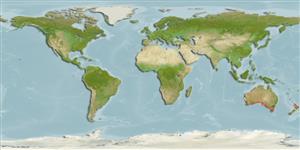>
Eupercaria/misc (Various families in series Eupercaria) >
Sparidae (Porgies)
Etymology: Acanthopagrus: Greek, akantha = thorn + Greek, pagros, a kind of fish (Ref. 45335).
Eponymy: Alfred Dunbavin Butcher (1915–1990) was an Australian zoologist. [...] (Ref. 128868), visit book page.
Environment: milieu / climate zone / depth range / distribution range
экология
морской; пресноводный; солоноватоводный демерсальный. Subtropical; 23°S - 44°S, 112°E - 154°E
Indo-Pacific: endemic to southern Australia.
Length at first maturity / Size / Вес / Возраст
Maturity: Lm ?, range 16 - ? cm
Max length : 60.0 cm TL самец/пол неопределен; (Ref. 2156); common length : 24.0 cm TL самец/пол неопределен; (Ref. 2156); наибольший вес (опубликованные данные): 4.0 kg (Ref. 26523); наибольший возраст (опубликованны данные): 29 годы (Ref. 36820)
Краткое описание
определительные ключи | морфология | морфометрия
колючие лучи спинного плавника (общее число) : 10 - 13; членистые (мягкие) лучи спинного плавника (общее число) : 10 - 13; колючие лучи анального плавника: 3; членистые (мягкие) лучи анального плавника: 8 - 10. The upper body can vary from silvery to golden brown, bronze, green or black depending on habitat. Chin and belly are usually white and fins are dusky to greenish black. Dorsal and ventral profiles of adults are similarly convex.
Endemic in coastal areas, rivers and estuaries of Australia. Most abundant in river mouths and estuaries (Ref. 28468, 28472). Inhabit brackish waters of coastal rivers and lakes, occasionally penetrating fresh water (Ref. 44894). Considered as the only true estuarine sparid in Australia. Larvae and small juveniles are most abundant over seagrass beds in shallow estuarine waters (Ref. 28468, 28472). Spawning period varies considerably between estuaries (Ref. 28468). Remain upstream in sheltered waters to spawn and is not usually found in purely marine habitats (Ref. 44894). Feed on shellfish, worms, crustaceans, small fish and algae. Sold as whole, chilled products in domestic markets (Ref. 6390). One of top angling species in southern Australia (Ref. 6390, 44894), as well as being a delicious table fish (Ref. 2156).
It is not known whether there is any sex inversion in black bream (Ref. 6390).
Kailola, P.J., M.J. Williams, P.C. Stewart, R.E. Reichelt, A. McNee and C. Grieve, 1993. Australian fisheries resources. Bureau of Resource Sciences, Canberra, Australia. 422 p. (Ref. 6390)
Статус Красного Списка МСОП (Ref. 130435: Version 2024-2)
Угроза для людей
Harmless
Использование человеком
рыболовство: коммерческий; объект спортивного рыболовства: да
дополнительная информация
инструменты
Специальные отчеты
Скачать в формате XML
ресурсы в Интернет
Estimates based on models
Preferred temperature (Ref.
123201): 14.7 - 20.6, mean 17.6 °C (based on 126 cells).
Phylogenetic diversity index (Ref.
82804): PD
50 = 0.5000 [Uniqueness, from 0.5 = low to 2.0 = high].
Bayesian length-weight: a=0.01259 (0.01137 - 0.01394), b=3.04 (3.01 - 3.07), in cm total length, based on LWR estimates for this species (Ref.
93245).
Trophic level (Ref.
69278): 3.5 ±0.53 se; based on food items.
Generation time: 4.1 (3.7 - 6.9) years. Estimated as median ln(3)/K based on 16
growth studies.
устойчивость к внешним воздействиям (Ref.
120179): низкий, минимальное время удвоения популяции 4.5-14 лет (K=0.11; tm=2-5; tmax=29).
Fishing Vulnerability (Ref.
59153): Moderate vulnerability (41 of 100).
Nutrients (Ref.
124155): Calcium = 76.4 [42.1, 142.3] mg/100g; Iron = 1.07 [0.62, 1.89] mg/100g; Protein = 20 [19, 21] %; Omega3 = 0.36 [0.25, 0.57] g/100g; Selenium = 21.1 [10.4, 38.9] μg/100g; VitaminA = 9.49 [3.31, 24.31] μg/100g; Zinc = 0.832 [0.594, 1.137] mg/100g (wet weight);
